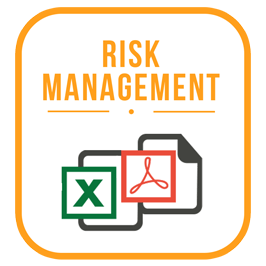Calculating Value at Risk - Package
About the Course
The course consists of two pdf files and 7 EXCEL files.
It begins with the PDF “Calculating Value at Risk (VaR) – including case studies” which presents an overview of the various Value at Risk (VaR) calculation methods. A step by step guide to calculate VaR under the Variance Covariance (VCV) & Historical Simulation approaches for a simple portfolio of securities is presented. The limitations and related caveats pertaining to the use of this risk metric are then discussed.
This is followed by a more comprehensive walkthrough of how VaR may be calculated in EXCEL using the VCV, Historical Simulation and Monte Carlo simulation approaches with accompanying EXCEL file (Calculating VaR - EXCEL). “The FI – Rate, Price and Delta Normal VaR” EXCEL file shows how to calculate VaR for bonds under various approaches. Rate VaR which only considers interest rates, Price VaR or the full valuation approach that includes the bond’s characteristic and interest rate sensitivity in the calculation, an an approximation to Price VaR called the Delta Normal approach.The Portfolio VaR EXCEL file further demonstrates the calculation of portfolio VaR using the Variance Covariance Matrix multiplication approach as well as the weighted average portfolio return approach. The calculation of 10-day trailing volatilities and building of histogram of trailing volatilities for the portfolio using EXCEL’s Data Analysis Histogram function is shown and a crude estimate of the VaR number using the maximum volatility from this trailing volatility series is also calculated.
A comparison and discussion of the uses of other VaR related metrics such as Incremental VaR (IVAR), Marginal VaR, Conditional VaR and Probability of Shortfall are also covered with supporting EXCEL file (Comparing Value at Risk - Model, Methods and Metrics – EXCEL).
Three case studies demonstrate the use of VaR in non-traditional areas. These include the use of the metric in forecasting the margin shortfall problem within the oil, gas and petrochemical industry; in estimating price shocks for jet fuel & shortfalls in profit margins; and in determining margin requirements for hedge funds in prime brokerage together with estimating their probabilities of default (PDs) and losses given default (LGDs).
The course includes two EXCEL files that demonstrate methodologies for calculating Value at Risk (VaR) for derivative instruments. The first “Value at Risk Example for Fixed For Floating Interest Rate Swaps” calculates historical simulation VaR for a fixed for floating interest rate swaps. The second “Calculating VaR for Futures and Options” calculates VCV and historical simulation VaR for futures and options.
The “Value at Risk with Liquidity Premium” PDF, presents a VaR based approach for quantifying market liquidity risk with a detailed walkthrough of the accompanying EXCEL example “VaR with liquidity premium - EXCEL”. Market risk measures are calculated for base and stressed scenarios in turn for markets where trading volume is unlimited and where it is constrained. The latter measure produces a metric that is adjusted for market liquidity risk and inclusive of the liquidity premium.
Learning Objectives
After taking this course you will be able to:
- Define and interpret Value at Risk
- List the features of and differences between the various VaR approaches- Variance Covariance, Historical Simulation and Monte Carlo Simulation
- Calculate VaR under these different approaches in EXCEL
- Calculate Rate Value, Delta Normal VaR and Price VaR for fixed income securities
- Identify the limitations of and qualifications to using the VaR measure
- Calculate Portfolio VaR using the short cut weighted average approach as well as the VCV matrix multiplication approach
- Calculate trailing volatilities for individual securities and a portfolio of securities
- Crudely estimate VaR using the trailing volatility series
- Graph the distribution of returns and trailing volatilities using EXCEL’s Data Analysis Histogram function
- Define and calculate VaR related risk metrics, such as Incremental VaR, Marginal VaR, Conditional VaR and Probability of Shortfall
- Apply the VaR calculations in various real-world case-studies such as calculating input/output price change impacts on profitability, determining margin requirements, evaluating hedge effectiveness.
- Construct a pricing model for a fixed for floating interest rate swap, use EXCEL’s Data table functionality to generate a price series for the interest rate swap, and calculate historical simulation VaR for the instrument
- Construct a Monte Carlo Simulator based model to determine the payoffs, prices and VaR metrics for futures, call & put options
- Calculate market liquidity risk under base and stressed market risk scenarios
Prerequisites
The candidate should be comfortable with basic mathematics, statistics, probability and EXCEL, some familiarity with markets, including derivative markets, and portfolio management.
Target Audience
The course is targeted towards intermediate and advanced users and is aimed primarily at individuals responsible for capital allocation, limit setting and risk management within banks, insurance companies, mutual funds, as well as finance departments of non-financial organizations who need to quickly review or refresh their understanding of VaR methodologies for work or professional development.

